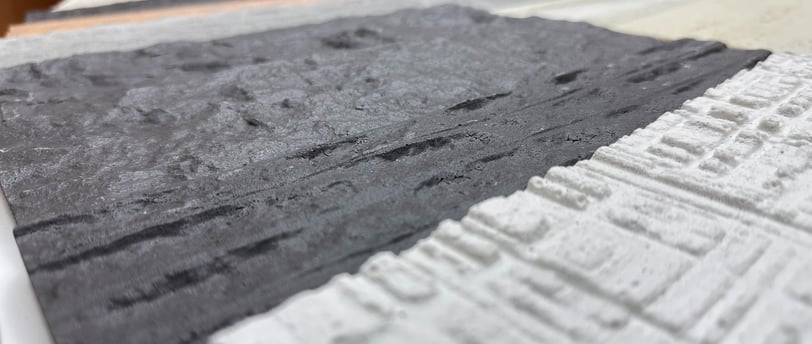Environmental Issues Demand Immediate Action: The Emergence of Soft Stone as a New Exterior Wall Decoration Material
The Role of Green Building Materials: Comparing Ceramic Tiles, Natural Stone, and Soft Stone in Reducing Environmental Pollution


The Role of Green Building Materials: Comparing Ceramic Tiles, Natural Stone, and Soft Stone in Reducing Environmental Pollution
Environmental pollution is a growing concern worldwide, with the construction industry being a significant contributor. From the extraction of raw materials to manufacturing processes and waste generation, traditional building practices often leave behind a considerable ecological footprint. As awareness of sustainability grows, green building materials are gaining attention for their ability to mitigate pollution and promote eco-friendly practices. In this blog, we’ll focus on comparing ceramic tiles, natural stone, and soft stone as building materials, highlighting their environmental impacts and the advantages of soft stone in creating a greener future.
Ceramic Tiles: Durable but Resource-Intensive
Ceramic tiles are widely used in construction due to their durability, versatility, and aesthetic appeal. However, their production process involves several environmental challenges:
High Energy Consumption: Ceramic tile manufacturing requires firing at high temperatures, consuming significant amounts of energy and contributing to greenhouse gas emissions.
Raw Material Extraction: The clay and minerals used in ceramic tiles are extracted from the earth, leading to habitat destruction and soil erosion.
Waste Generation: Broken or unused tiles often end up in landfills, adding to construction waste.
While ceramic tiles are long-lasting and low-maintenance, their production process leaves a notable environmental footprint, making them less sustainable compared to newer alternatives.
Natural Stone: A Timeless Choice with Environmental Costs
Natural stone, such as marble, granite, and limestone, has been a popular choice for centuries due to its beauty and durability. However, its environmental impact is often overlooked:
Resource Depletion: Quarrying natural stone involves extracting large amounts of material from the earth, leading to irreversible damage to landscapes and ecosystems.
Energy-Intensive Processing: Cutting, polishing, and transporting heavy stone slabs require substantial energy, contributing to carbon emissions.
Limited Recycling Options: Natural stone waste is challenging to recycle, and discarded pieces often end up as landfill waste.
While natural stone is a premium material with unmatched aesthetic qualities, its environmental costs make it less favorable in the context of sustainable construction.
Soft Stone: A Green Alternative
Soft stone is an innovative material that offers a sustainable solution to many of the environmental issues associated with ceramic tiles and natural stone. Here’s why soft stone stands out:
Eco-Friendly Production: Soft stone is often made from recycled materials or natural components, significantly reducing the need for raw material extraction and minimizing environmental disruption.
Energy Efficiency: The manufacturing process of soft stone typically consumes less energy compared to ceramic tiles or natural stone processing, leading to lower carbon emissions.
Lightweight and Transportable: Soft stone is lighter than natural stone, reducing transportation energy costs and emissions.
Recyclable and Waste-Reducing: Soft stone is designed to be recyclable, promoting circular construction practices and reducing landfill waste.
Versatile and Durable: Soft stone combines the aesthetic appeal of natural stone with the durability of ceramic tiles, making it a practical and sustainable choice for various applications.
Environmental Benefits of Soft Stone
Soft stone addresses many of the pollution-related challenges posed by traditional building materials:
Lower Carbon Footprint: Its energy-efficient production process and lightweight nature significantly reduce greenhouse gas emissions.
Reduced Resource Depletion: By utilizing recycled materials, soft stone helps conserve natural resources and reduces the need for quarrying or mining.
Promoting Waste Management: Its recyclability supports sustainable construction practices, ensuring less waste ends up in landfills.
Improved Indoor Air Quality: Soft stone is often free from harmful chemicals or VOCs, contributing to healthier indoor environments.
Conclusion
As the construction industry seeks to align with sustainable practices and reduce environmental pollution, the choice of building materials plays a crucial role. While ceramic tiles and natural stone have long been favored for their durability and aesthetics, their environmental impacts cannot be ignored. Soft stone emerges as a green alternative, offering comparable benefits while addressing the critical issues of energy consumption, resource depletion, and waste generation.
We are proud to be the manufacturer of this revolutionary product, bringing cutting-edge technology and eco-friendly practices to the forefront of modern construction. Our soft stone brand sinoflexistone operates under Homevipotech, a trusted name dedicated to innovation and sustainability in the building materials industry.
With a commitment to quality and the environment, we aim to provide solutions that not only meet the demands of contemporary architecture but also contribute to a greener, healthier planet.
من نحن
تحت مظلة HomevipoTech، تقدم سينوفلكسيستون جمال وأداء الحجر الناعم إلى الحياة. بصفتنا منتجًا رائدًا، نصنع تشطيبات حجرية مرنة ومقاومة للعوامل الجوية وذات جاذبية جمالية، مما يوفر حلولاً عصرية ومستدامة وقليلة الصيانة لمجموعة واسعة من المساحات.
تواصل مع صوفي.
أي استفسار
info@sinoflexistone.com
+86 18688226660/18928543384
© 2025. All rights reserved.
